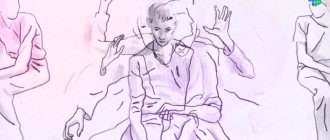What is dysphoria
Dysphoric disorder is characterized by a constant gloomy, gloomy mood with causeless irritability, anger, hysteria, and outbreaks of aggression arise completely spontaneously, for no apparent reason. The pathogenetic cause of this condition is a violation of the processes of production and reuptake of neurotransmitters - substances that are “responsible” for the transmission of nerve impulses and determine all the emotions experienced by a person.
It is the deficiency of norepinephrine, dopamine and serotonin that causes all the symptoms characteristic of dysphoria. In addition, such malfunctions in the functioning of the central nervous system often become the cause of other diseases, which, according to the modern classification, are combined into the group of psychosomatic disorders. To date, the connection between dysphoria and autoimmune pathologies, oncology, diseases of the cardiovascular and endocrine systems has been proven.
A hyperbolic reaction to even minor troubles increases the risk of heart attacks and strokes at an early age, chronic hypertension, and serious metabolic disorders. There is a high probability of damage to the gastrointestinal tract (gastritis, colitis, pancreatitis); it has already been established that dysphoria is one of the main etiological factors of gallbladder dysfunction.
In psychology
From the point of view of psychologists, dysphoria is a negative emotion, manifested by low mood with gloominess, irritability and anger. In a state of dysphoria, a person is impatient and unrestrained; even a slight irritant can cause a violent reaction of anger and aggression. Like any negative emotion, it arises from a situation that is subjectively assessed as undesirable or unpleasant. Anyone can experience dysphoria, but those who are tired or sick often experience it, while those who are rested and healthy rarely experience it.
Causes
Dysphoria should be clearly differentiated from a bad, depressed mood caused by external circumstances. According to experts, neurotransmitter imbalances are based on:
- hereditary features of the functioning of the central nervous system;
- systematic alcohol abuse, drug use;
- organic brain damage as a result of severe traumatic brain injury, chronic hypoxia, or stroke.
However, even in the presence of these disorders, dysphoric disorder does not always develop. Symptoms of the disease can be caused by:
- overwork, too intense physical and mental stress;
- violation of daily routine, chronic lack of sleep;
- stress caused by any problems in the family or at work;
- withdrawal syndrome due to sudden withdrawal from psychostimulants;
- conflicts with loved ones, colleagues;
- psychotrauma;
- hormonal imbalances caused by any disease or physiological age-related changes;
- serious illness diagnosed in oneself or relatives, etc.
Dysphoria is a symptom of a number of other psychoneurological diseases:
- depression;
- post-traumatic, generalized anxiety disorder;
- psychosis;
- neuroses and neurasthenia;
- schizophrenia, etc.
Symptoms
In a state of dysphoria, a person looks gloomy, tense and wary. When communicating, such people are rude, prone to petty touchiness and picky. Characterized by increased sensitivity to sound, smell, bright light, and touch. There are almost always somatic manifestations in the form of increased heart rate, breathing, impaired muscle tone (convulsions, twitching, tics) and vegetative symptoms. With severe dysphoria, aggressive behavior towards oneself (self-cutting, self-harm) or towards others (insults, threats, beatings, etc.) is possible.
Clinical manifestations
The main signs of dysphoria include:
- apathy;
- melancholy;
- decreased performance, exercise intolerance;
- anxiety, restlessness;
- unpredictable outbursts of anger and aggression, physical violence and attempted attacks are not excluded;
- offensive, malicious statements addressed to others.
In addition, dysphoria is often accompanied by somatic disorders:
- insomnia with nightmares;
- weakness, weakness;
- shortness of breath;
- headache, tachycardia;
- pulsation in the temples and ears, especially during attacks of anger;
- paroxysmal or chronic pain in the chest, abdomen;
- eating disorders (worsening of appetite or, conversely, overeating, anorexia, bulimia);
- deterioration of the condition of the skin, hair and nails;
- menstrual disorders, decreased libido, and in men - impotence.
Dysphoric disorder also causes serious disturbances in the functioning of the immune system , which reduces the body's resistance to various types of viral and bacterial infections.
Somatized (cathesthetic) dysthymia
Somatized dysthymia is characterized by complaints of general poor health, palpitations, shortness of breath, constipation, tearfulness, poor sleep with frequent awakenings. Depressed mood is usually mild with a predominance of anxiety. Often, bodily sensations overlap with mood disorders with the formation of general symptoms. At the same time, depression and melancholy acquire a physical connotation (burning in the larynx or intestines, “icy cold” “in the pit of the stomach”
). In the first stages, the intensity of low mood, as well as anxious fear for one’s health, fluctuates due to changing living conditions. Subsequently, external events have less and less impact on the dynamics of clinical manifestations. In this case, either the phenomena of asthenia come to the fore (anxiety and restlessness are replaced by decreased activity, physical impotence, and tension by lethargy), or, conversely, the range of abnormal bodily sensations expands, and introspection intensifies.
Characterological (characterogenic) dysthymia]
Synonym: constitutional-depressive personality type according to P. B. Gannushkin. The clinical picture is dominated by persistent disorders that persist throughout life in the form of anhedonia, a tendency to “the blues,” pessimism, and thoughts about the meaninglessness of life. Over the years, a depressive worldview is gradually formed, at the center of which lies the “loser complex.” As P.B. Gannushkin points out, “the picture of the world seems to be covered with a mournful flair for them, life seems meaningless, they look only for the dark sides in everything. These are born pessimists. Every joyful event is immediately poisoned for them by the thought of the fragility of joy, they expect nothing from the future except misfortune and difficulties, while the past only brings remorse over real or imaginary mistakes they have made. They are extremely sensitive to all sorts of troubles, sometimes react very sharply to them, and in addition, some vague feeling of heaviness in the heart, accompanied by an anxious expectation of misfortune, constantly haunts many of them. ... Eternally gloomy, gloomy, dissatisfied and silent, they involuntarily alienate even those who sympathize with them. ... In their external manifestations, in their movements, in their facial expressions, for the most part, traces of some kind of inhibition are visible: drooping facial features, limply hanging hands, a slow gait, stingy, sluggish gestures - all of this reeks of hopeless despondency. Any kind of work or activity is for the most part unpleasant for them, and they soon get tired of it. In addition, they notice mainly mistakes in what has been done, and so many difficulties in what lies ahead that they involuntarily give up in anticipating them. In addition, most of them are usually incapable of prolonged volitional tension and easily fall into despair. All this makes them extremely indecisive and incapable of any effective initiative. Intellectually, this kind of people often stand very high, although, for the most part, mental work is colored unpleasantly for them, accompanied by a feeling of great tension ... "It should be clarified that the idea that the tendency to depression is a character trait or a feature of temperament is now being questioned individual. It is assumed that in fact there is a chronic depressive or dysthymic disorder that arose in childhood under the influence of external factors.
Diagnostic and treatment methods
To determine how to treat dysphoria, medical specialists need to find out the exact cause of the disorder and identify possible concomitant diseases. Often, questionnaires and psychotherapeutic testing are not enough, and additional laboratory and instrumental studies are needed:
- EEG, Dopplerography, brain tomography;
- determination of hormonal levels;
- Ultrasound of internal organs;
- ECG, ECHO-CG;
- according to indications - screening for autoimmune and oncological diseases.
The main method of treating dysphoria is regular consultations with a psychologist . Psychoanalysis and cognitive behavioral psychotherapy will help the patient cope with internal tension and more easily experience conflict and stressful situations.
Non-drug methods for correcting dysphoria are of great importance:
- art therapy;
- proper nutrition (if necessary, we help create a rational diet for weight loss/gain);
- physical exercise;
- daily walks in the fresh air;
- activities that distract from work and everyday worries.
Cost of services
| CONSULTATIONS OF SPECIALISTS | |
| Initial consultation with a psychiatrist (60 min.) | 6,000 rub. |
| Repeated consultation | 5,000 rub. |
| Consultation with a psychiatrist-narcologist (60 min.) | 5,000 rub. |
| Consultation with a psychologist | 3,500 rub. |
| Consultation with Gromova E.V. (50 minutes) | 12,000 rub. |
| PSYCHOTHERAPY | |
| Psychotherapy (session) | 7,000 rub. |
| Psychotherapy (5 sessions) | 30,000 rub. |
| Psychotherapy (10 sessions) | 60,000 rub. |
| Group psychotherapy (3-7 people) | 3,500 rub. |
| Psychotherapy session with E.V. Gromova (50 minutes) | 12,000 rub. |
| TREATMENT IN A HOSPITAL | |
| Ward for 4 persons | 10,000 rub./day |
| Ward for 3 persons | 13,000 rub./day |
| Ward 1 bed VIP | 23,000 rub./day |
| Individual post | 5,000 rub. |
| PETE | 15,000 rub./day |
This list does not contain all prices for services provided by our clinic. The full price list can be found on the “Prices” , or by calling: 8(969)060-93-93. Initial consultation is FREE!
Drug treatment
Medicines are prescribed when there is no visible effect from psychotherapy. To minimize the risk of adverse reactions and complications, the treatment regimen is always selected on an individual basis. Apply:
- mood stabilizers (lithium salts);
- sedatives and hypnotics (short-term course until the general psycho-emotional state is normalized);
- B vitamins, antioxidants;
- medications for the correction of concomitant diseases.
But most often, antidepressants are used, which act directly on the pathogenetic mechanisms of the development of dysphoria.
Ideally, treatment should begin as quickly as possible, without waiting for the depressive state to worsen and the development of concomitant psychosomatic diseases. To make an appointment, call us 24 hours a day 8(969)060-93-93.
Who is affected by this?
Until recently, studies of postcoital dysphoria were conducted in women. In one of them, among 230 female students, approximately 46% admitted to scientists that they had felt sad after sex at least once in their lives. 5% of participants said they had experienced these symptoms in the past four weeks. Another study conducted among the same target group - female university students - showed similar results.
But more recent research shows that these experiences are familiar to men, too. One of them, published in the scientific journal “Sex and Marital Therapy” in 2018, found that out of 1,200 men surveyed, 41% experienced post-coital dysphoria at least once in their lives, 20% - at least once in the last four weeks, 3% regularly.










